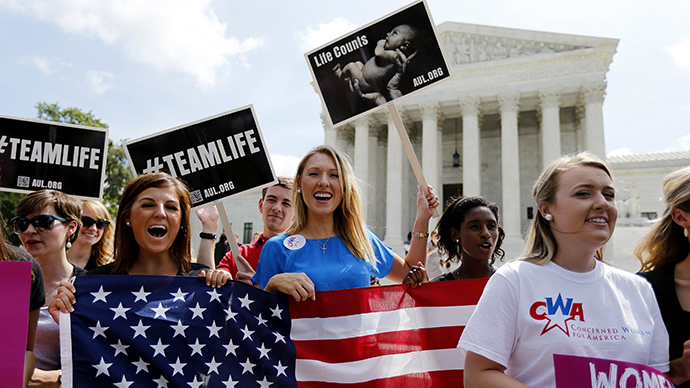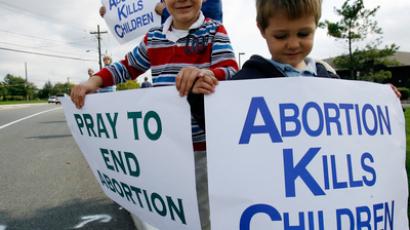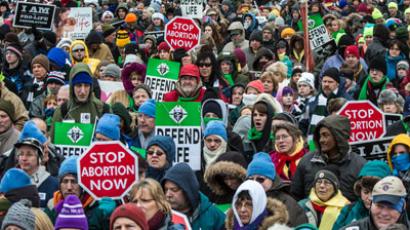Supreme Court rules buffer zones around abortion clinics unconstitutional

Buffer zones around abortion clinics that restrict access to public sidewalks are an unconstitutional restriction on speech, the Supreme Court ruled unanimously Thursday. The zones were designed to keep protesters at bay.
The 2007 amendment to a Massachusetts law stated that protesters had to remain at least 35 feet from the entrances of any reproductive health care facility to prevent confrontations. The legislature increased the zone from an 18-foot buffer created in 2000 because protesters still blocked entrances and intimidated patients. The legislation stemmed from public safety concerns after John Salvi III killed two people during a shooting rampage at abortion clinics in the Boston suburbs in 1994, as well as violent demonstrations and protests outside entrances of clinics, the Boston Globe reported.
Eleanor McCullen, a grandmother who stands outside a Boston-area Planned Parenthood clinic twice a week, sued the commonwealth over the buffer, saying she and other opponents of abortion sought “not merely to express their opposition to abortion, but to inform women of various alternatives and to provide help in pursuing them,” court documents said.
The buffer zones “definitely impeded our message,” she said to the Globe. “If someone isn’t interested, that’s fine. But I’d like to be there to help.” Many clinic visitors are hesitant about the decision and are therefore receptive to her viewpoint, she added.
The nine high court justices agreed with McCullen, saying the law burdened free speech more than necessary to achieve Massachusetts’ desired effect.
“Petitioners are individuals who approach and talk to women outside such facilities, attempting to dissuade them from having abortions. The statute prevents petitioners from doing so near the facilities’ entrances,” the court wrote. “By its very terms, the Massachusetts Act regulates access to ‘public ways’ and ‘sidewalks.’ Such areas occupy a ‘special position in terms of First Amendment protection’ because of their historic role as sites for discussion and debate.”
Chief Justice John Roberts wrote the opinion for the court, which called the closing of sidewalks an “extreme step” that didn’t “seriously [address] the problem through alternatives that leave the forum open for its time-honored purposes.”
Reproductive rights advocates panned the ruling, who cited the National Abortion Federation (NAF), which closely tracks threats and violence against abortion providers across the country. The NAF has found that buffer zones have a measurable impact, decreasing criminal activity and increasing patients’ and staff members’ access to the facilities.
“Buffer zones make a huge difference,” Ashley Hartman, who holds a master’s in public health from Ohio State University and has volunteered as a clinic escort in the Cleveland area, said in an interview with ThinkProgress. “The reality is, if you’ve ever been outside a clinic, it’s not about exchanging ideas… Protesting is about creating the feeling of intimidation, so the more distance you can have from them, the less powerful that intimidation is.”
“The fact that we even have clinic escorts is a good signifier that we need things like buffer zones,” she pointed out. “We wouldn’t need escorts if walking into a clinic didn’t involve that type of harassment.”
Planned Parenthood, which offers health services like gynecological check-ups, testing for sexually transmitted diseases, access to birth control and emergency contraception, and assistance for women wishing to terminate pregnancies, as well as prenatal care for those who don’t plan to abort, also spoke out against the ruling.
“This decision shows a troubling level of disregard for American women, who should be able to make carefully considered, private medical decisions without running a gauntlet of harassing and threatening protesters,” Cecile Richards, president of Planned Parenthood Federation of America, said in a statement.
Massachusetts Attorney General Martha Coakley, who defended the law in front of the high court, vowed that the fight to protect women in front of abortion clinics was not over.
“With today’s decision, our work begins again. We are not going to give up our fight to make sure women have safe access to reproductive health care. We will utilize all of the tools we have available to protect everyone from harassment, threats, and physical obstruction,” Coakley said in a statement. “I will work with the Governor, Legislature and advocates to explore additional legislative tools that also meet the court’s requirements.”
Coakley also noted at an afternoon press conference that the justices did not strike down a provision of the law that prohibits the “intentional blocking” of abortion clinics. She said her office’s civil rights division was prepared to issue injunctions against “those who would threaten or harass.”
Massachusetts may be able to rework their legislation to create a moving “no-approach zone” as people approach an abortion clinic. In 2000, the Supreme Court upheld a Colorado law that created a 100-foot buffer zone outside all health-care facilities. Within that zone, the law bans people from approaching patients within eight feet without their consent. The Baystate previously had a floating buffer, but found that it was too difficult for police to enforce.
The Supreme Court noted in its ruling that difficulty enforcing moving buffers was not reason enough to do away with them. “A painted line on the sidewalk is easy to enforce, but the prime objective of the First Amendment is not efficiency,” the court said.
Justices Antonin Scalia and Samuel Alito, in their concurring opinions, also noted that the buffer zones discriminated against abortion opponents.
“Speech-free zones ... add nothing to safety and access; what they achieve, and they were obviously designed to achieve, is the suppression of speech opposing abortion,” Scalia wrote.
“It is clear on the face of the Massachusetts law that it discriminates based on viewpoint,” Alito wrote. “Speech in favor of the clinic and its work by employees and agents is permitted; speech criticizing the clinic and its work is a crime. This is blatant viewpoint discrimination.”














